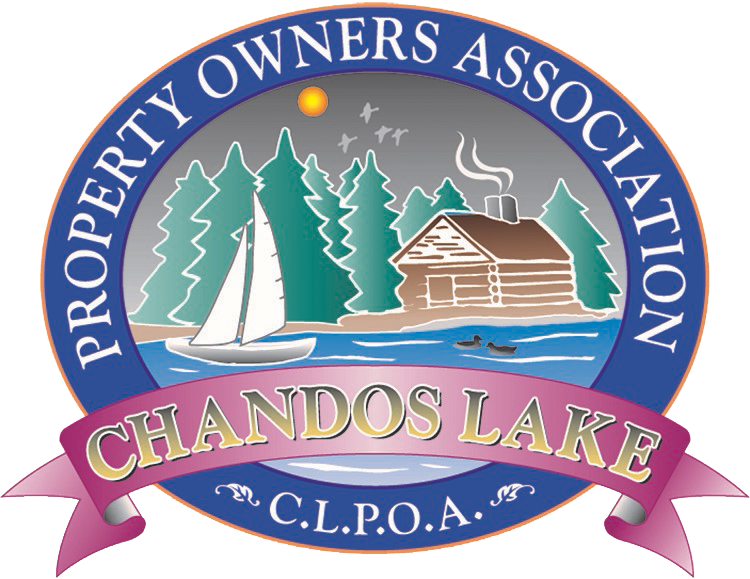Photo: Trent University
Eurasian Watermilfoil Management Project

What is the Eurasian Watermilfoil Management Project?
In response to residents and environmental representatives, the CLPOA initiated an Aquatic Invasive Species (AIS) management project in 2018 in association with Trent University. The research project focuses on managing the invasive aquatic plant Eurasian watermilfoil (Myriophyllum spicatum) invading Chandos Lake. The management project is completed in an integrated approach, with two principle pillars:
- Placement of benthic mats seeded with vegetation. The mats are made of biodegradable materials, such as coconut husk. They are laid on the lake bottom after Eurasian watermilfoil is removed. They act much like a shade cloth does in a garden, and prevent milfoil from growing after treatment. To further accelerate restoration of the site, native aquatic plants are seeded in the mat.
- Release of milfoil weevils (Euhrychiopsis lecontei) a small aquatic insect. This native insect is used as a form of biocontrol and feeds on the Eurasian watermilfoil over the summer.
What are the phases of the project?
Phase 1 (summer of 2018) – Five control and five treatment sites were selected around the lake where active management took place. Control sites were also set up to monitor changes without active intervention. Each treatment site received one benthic mat (2m by 8m in size) and a portion of the 25,000 total weevils released.
Phase 2 (summer of 2019) – Expanded research project by installing an additional 80 benthic mats. Of these 75 were new locations, that have been coordinated with participating cottagers and approved by the Ministry of Natural Resources and Forestry. The remaining 5 mats were used to revamp treatment sites from 2018. The mats are the same dimensions and materials used in the previous year with desirable native aquatic plants seeded in the mats.
Due to the rapidly cooling temperatures experienced in early September 2019, the mat program ended several weeks before our extended deadline of September 27th. Decreasing water temperatures made it no longer safe for the students to conduct work in the water and install mats. As such, all of you who did not receive a mat in 2019, will receive one starting July 15th, 2020. Please contact Alex Haney, Love Chandos Lake Director below to request a full refund. You will be contacted prior to the mat installations to coordinate placement.
A few lessons were learned in 2019, the first year of the CLPOA solely installing the benthic mats and treating milfoil. Longer time frames are needed for confirming mat locations and processing Ministry permits. As such, all locations for 2020 will need to be confirmed by the end of April 2020. Some treatment sites did not have large milfoil populations while some had very large patches. It’s important to confirm the presence of the invasive Eurasian watermilfoil before requesting and purchasing a mat. Eurasian watermilfoil fragments very easily, accelerating its potential to spread. Increasing care is needed to collect debris, to prevent it from recolonizing treatment areas. Installers will need to have a ready supply of rocks and native aquatic plants when installing mats, as they are not present in every site. Interestingly, it appears native species are feeding on small amounts of milfoil. Canada geese were seen regularly eating Eurasian watermilfoil growing on the surface. Not sure if it’s a control solution, but helpful!
There is still room on the waiting list for those interested in purchasing their own benthic mats next summer 2020. Each property owner can purchase two mats, for approximately each $325. This fee is subsidized by the CLPOA, and only includes the cost of materials. The remaining labour and miscellaneous costs are covered by the association.
Phase 3 (summer of 2021) –
After a pause in 2020, the Eurasian Watermilfoil Management Project will resume this summer. To honour the commitments made in 2019, we will install the 31 benthic mats previously purchased. Installation will be completed by professional divers from Dundee Marine after July 15th 2021. Members participating will be contacted closer to the start date with further details.
The CLPOA is also experimenting with floating tarps. They work in a similar manner to benthic mats, by blocking out sunlight and reducing milfoil growth. There will be 10 floating tarps placed across the lake.
In addition, we will use satellite images to, identify areas of milfoil growth and create a comprehensive map indicating milfoil hot spots. With this information we can track future milfoil spread and plan for future management.
We are not able to add any new mat locations this year due to ongoing COVID-19 concerns. We thank all those who indicated interest in mats for their patience and understanding. The CLPOA will continue to support membership in our efforts to manage invasive Eurasian watermilfoil and protect the health of Chandos Lake.
If you have any questions about the project, please contact the Environmental Committee, at lovechandoslake.clpoa@gmail.com.
Thank you for your continued support. Have a great summer!
– Alex Haney and Debra Anthony, Chair and Deputy Chair of the Environmental Committee
Project Publications
- CLPOA Love Chandos Lake Director, Alex Haney letter – July 5, 2018
- Project Overview – Love Chandos Lake Director – July 5, 2018
- CLPOA Love Chandos Lake Director letter – Aug. 24, 2018
- CLPOA Love Chandos Lake Director letter – Feb. 2, 2019
- Trent University’s Progress Report – 2018
- Phase 2 of the Eurasian Watermilfoil Management Project – March 15, 2019
- Letter to Eurasian Watermilfoil Management Project Participants – March 15, 2019
- Two changes to Phase 2 of Eurasian Watermilfoil Management Project – June 21, 2019
- Action Request of Eurasian Watermilfoil Management Project Participants – June 25, 2019
- CLPOA Love Chandos Lake Director Project Update – Aug 30, 2019



